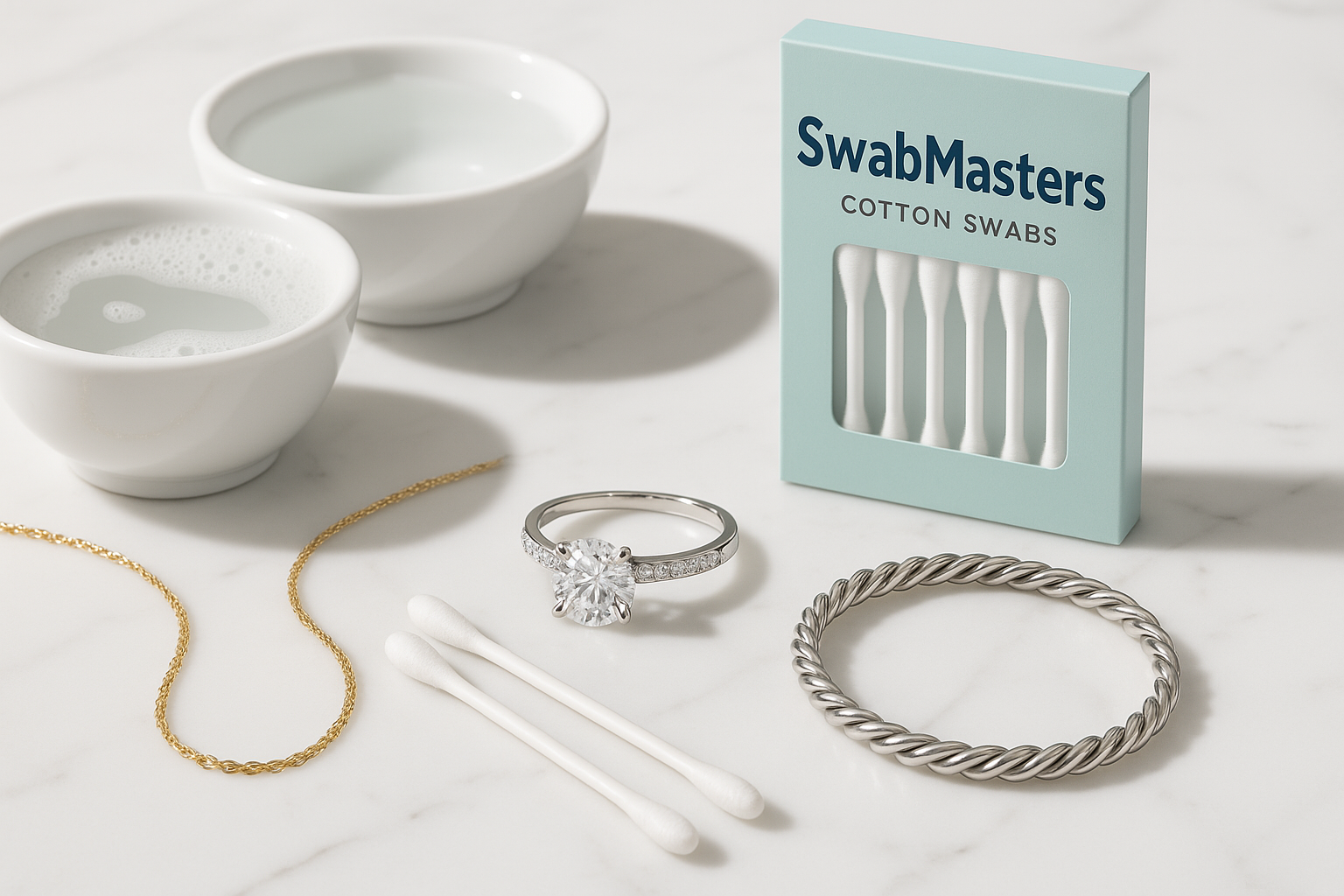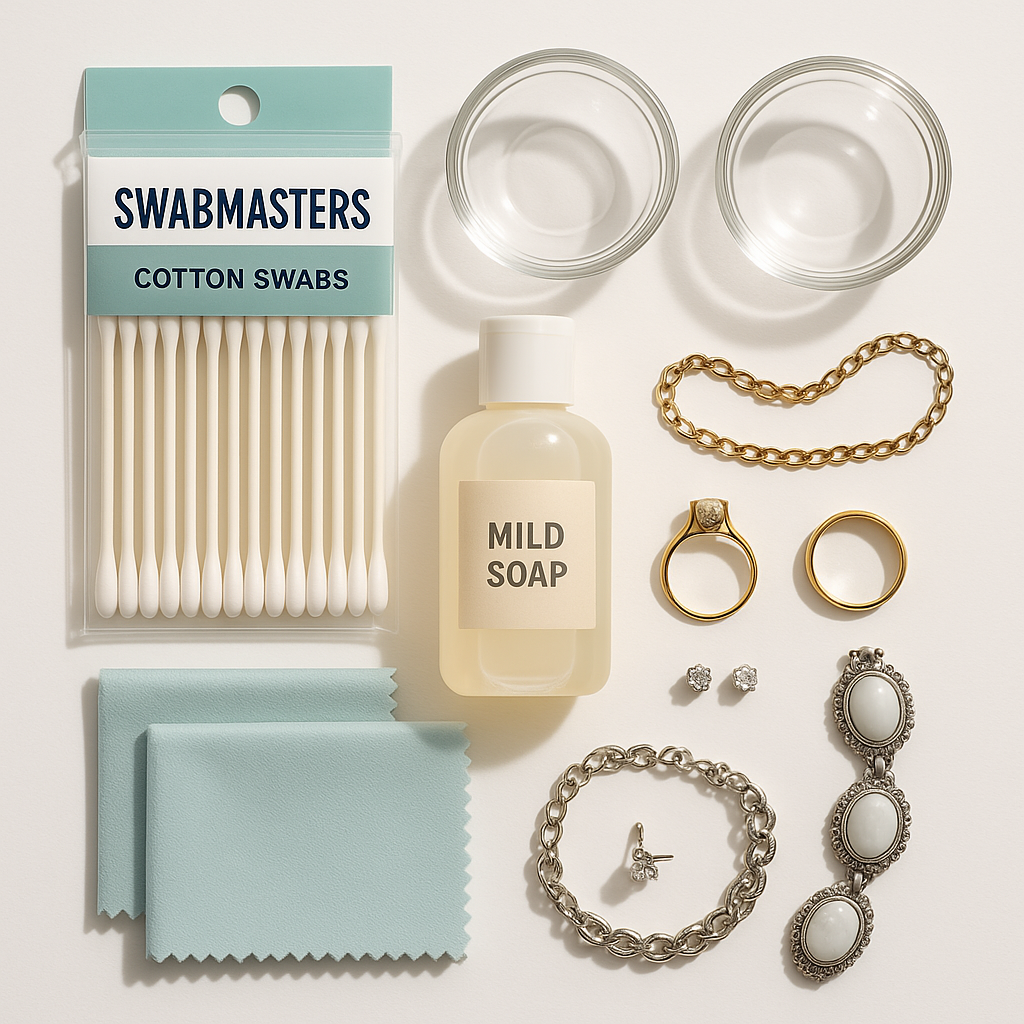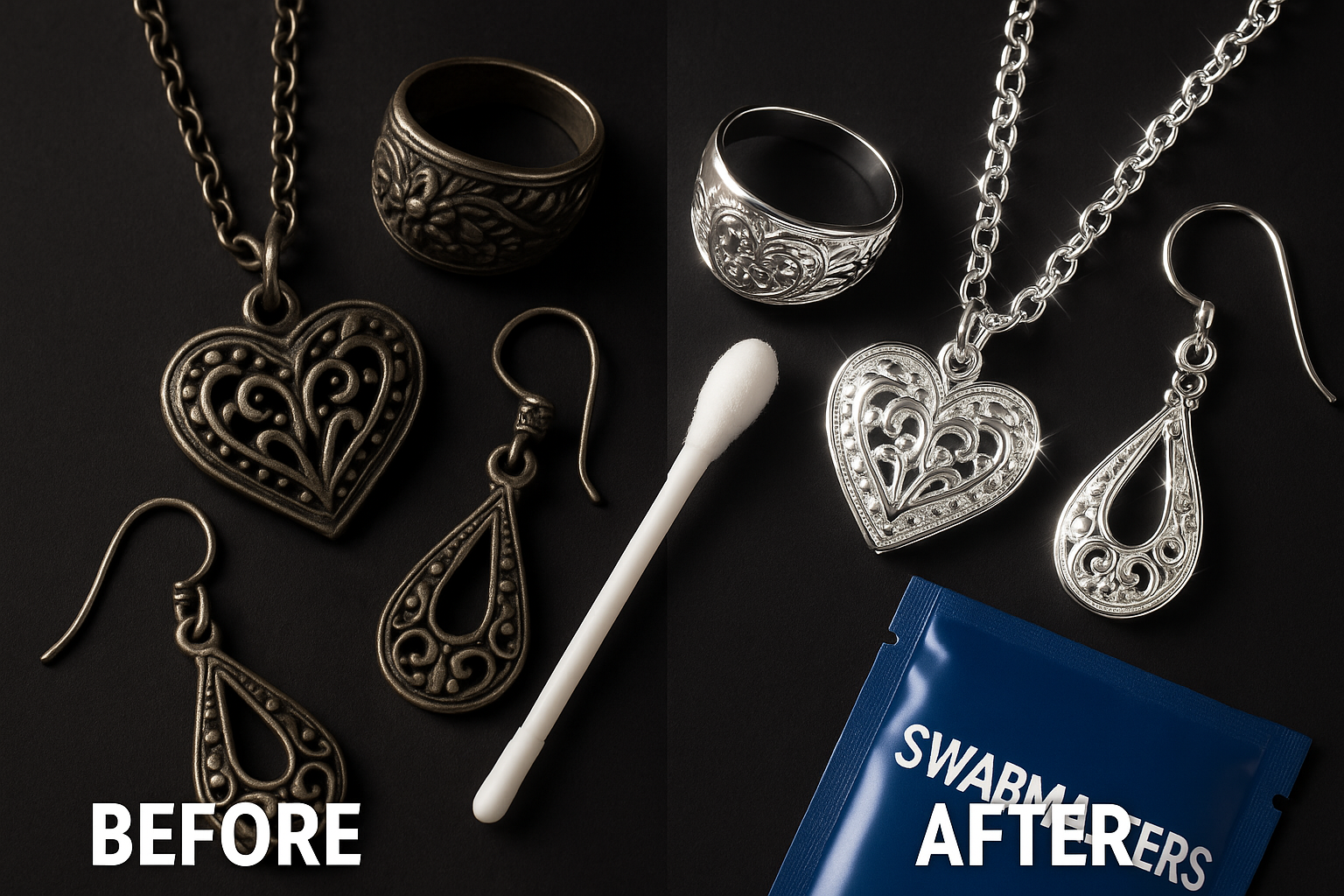
Professional jewelry cleaning setup featuring SWABMASTERS cotton swabs and sparkling jewelry
Your jewelry deserves to sparkle. But over time, dirt, oils, and grime build up on your favorite pieces. They lose their shine and look dull.
The good news? You can bring back that brilliant sparkle at home. Cotton swabs are your secret weapon for jewelry cleaning. They reach tiny spaces that other tools can’t touch.
This guide shows you 11 proven cotton swab methods. Each one targets different types of jewelry and cleaning challenges. You’ll learn simple techniques that work fast and cost little.
Why Cotton Swabs Work So Well for Jewelry Cleaning
Cotton swabs excel at jewelry cleaning for several key reasons. Their small, precise tips reach into tight spaces where dirt hides. The soft cotton material won’t scratch delicate surfaces like gold or silver.
Professional jewelers often use cotton swabs for detail work [1]. The absorbent cotton holds cleaning solutions well. This lets you apply just the right amount of cleaner to specific areas.
Cotton swabs also give you control. You can clean one small section at a time. This prevents damage to sensitive gemstones or delicate settings.

SWABMASTERS cotton swab precisely cleaning intricate ring details
What You Need Before You Start

Essential jewelry cleaning supplies including SWABMASTERS cotton swabs
Gather these basic supplies for cotton swab jewelry cleaning:
- SWABMASTERS cotton swabs – High-quality swabs that won’t shed fibers
- Mild dish soap – Choose fragrance-free varieties
- Warm water – Not hot, which can damage some stones
- Soft microfiber cloths – For drying and polishing
- Small bowls – For mixing cleaning solutions
- Rubbing alcohol – For disinfecting and removing oils
Always work in good lighting. This helps you see dirt and avoid missing spots. Remove jewelry before cleaning to prevent loss down drains.
Method 1: Basic Soap and Water Cotton Swab Cleaning
This gentle method works for most jewelry types. It’s safe for gold, silver, and most gemstones.
What you need:
- SWABMASTERS cotton swabs
- Mild dish soap
- Warm water
- Small bowl
Steps:
- Mix 2-3 drops of mild dish soap in a cup of warm water
- Dip the cotton swab in the soapy solution
- Gently clean around prongs, settings, and chain links
- Use circular motions on flat surfaces
- Rinse with clean water on a fresh swab
- Dry with a soft cloth
This method removes everyday dirt and oils [2]. The soap breaks down greasy buildup without harsh chemicals. Cotton swabs reach into crevices where dirt collects.
Best for: Daily cleaning of gold, silver, and platinum jewelry with stable gemstones.
Method 2: Alcohol-Based Deep Cleaning
Rubbing alcohol cuts through stubborn oils and disinfects your jewelry. This method works especially well for earrings and rings.
What you need:
- SWABMASTERS cotton swabs
- 70% rubbing alcohol
- Clean water
- Microfiber cloth
Steps:
- Dip cotton swab in rubbing alcohol
- Clean the jewelry surface with gentle pressure
- Focus on areas that touch your skin
- Use a second swab with clean water to rinse
- Dry immediately with microfiber cloth
Alcohol evaporates quickly and kills bacteria [3]. This makes it perfect for jewelry that touches your ears or fingers often. The cotton swab delivers alcohol precisely where needed.
Best for: Earrings, rings, and any jewelry exposed to skin oils and bacteria.
Method 3: Baking Soda Paste Method
Baking soda creates a mild abrasive paste that removes tarnish and stubborn grime. This method works great for silver jewelry.
What you need:
- SWABMASTERS cotton swabs
- Baking soda
- Water
- Soft cloth
Steps:
- Mix baking soda with a few drops of water to make paste
- Apply paste to cotton swab tip
- Gently rub tarnished areas in circular motions
- Use light pressure to avoid scratching
- Rinse with clean water on fresh swab
- Polish dry with soft cloth
Baking soda neutralizes acids that cause tarnish [4]. The mild abrasive action removes buildup without damaging metal surfaces. Cotton swabs let you target specific tarnished spots.
Best for: Silver jewelry with tarnish, vintage pieces, and oxidized areas.
Method 4: Hydrogen Peroxide Sanitizing
Hydrogen peroxide provides deep sanitizing power. It’s especially useful for earrings and body jewelry that need thorough disinfection.
What you need:
- SWABMASTERS cotton swabs
- 3% hydrogen peroxide
- Clean water
- Soft towel
Steps:
- Soak cotton swab in hydrogen peroxide
- Apply to jewelry surfaces, especially posts and backs
- Let sit for 30 seconds for sanitizing action
- Use clean swab with water to rinse thoroughly
- Dry completely with soft towel
Hydrogen peroxide kills germs and breaks down organic matter [5]. The bubbling action helps lift dirt from small crevices. Cotton swabs make precise application safe and easy.
Best for: Body jewelry, earrings, and pieces that need sanitizing.
Method 5: Vinegar Solution for Costume Jewelry
White vinegar safely cleans costume jewelry without damaging plating or glued stones. This gentle acid removes buildup and restores shine.
What you need:
- SWABMASTERS cotton swabs
- White vinegar
- Water
- Soft cloth
Steps:
- Mix equal parts white vinegar and water
- Dip cotton swab in solution
- Clean gently around stones and settings
- Avoid soaking – use swab for spot cleaning only
- Rinse with water-dampened swab
- Dry immediately to prevent water spots
Vinegar’s mild acidity dissolves mineral deposits and soap residue [6]. The diluted solution is gentle enough for plated metals and fragile costume pieces. Cotton swabs prevent over-wetting that could loosen stones.
Best for: Costume jewelry, plated pieces, and jewelry with glued elements.
Method 6: Toothpaste Polishing Technique
Non-gel toothpaste acts as a mild polishing compound. This method removes scratches and restores shine to metal surfaces.
What you need:
- SWABMASTERS cotton swabs
- Non-gel toothpaste (no whitening agents)
- Water
- Polishing cloth
Steps:
- Apply small amount of toothpaste to cotton swab
- Rub gently on metal surfaces in circular motions
- Focus on scratched or dull areas
- Use light pressure to avoid damage
- Rinse thoroughly with water on clean swab
- Polish with soft cloth for final shine
Toothpaste contains mild abrasives that smooth surface imperfections [7]. The fluoride helps protect metal from future tarnishing. Cotton swabs give you precise control over pressure and coverage.
Best for: Gold and silver jewelry with minor scratches or dullness.
Method 7: Lemon Juice Brightening
Fresh lemon juice naturally brightens metals and removes tarnish. The citric acid works gently to restore shine without harsh chemicals.
What you need:
- SWABMASTERS cotton swabs
- Fresh lemon juice
- Water
- Soft cloth
Steps:
- Squeeze fresh lemon juice into small bowl
- Dip cotton swab in lemon juice
- Apply to tarnished or dull areas
- Let sit for 2-3 minutes maximum
- Rinse immediately with water-soaked swab
- Dry thoroughly to prevent acid damage
Lemon’s natural acids break down tarnish and oxidation [8]. The vitamin C content helps brighten metal surfaces. Cotton swabs prevent over-application that could damage sensitive materials.
Best for: Silver jewelry, copper pieces, and lightly tarnished metals.
Method 8: Steam Cleaning with Cotton Swabs
Steam loosens stubborn dirt and grime. Combined with cotton swab precision, this method reaches the tightest spaces.
What you need:
- SWABMASTERS cotton swabs
- Steaming hot water
- Small bowl
- Tweezers for safety
Steps:
- Pour steaming water into bowl
- Hold jewelry over steam for 10-15 seconds
- Quickly use dry cotton swab to wipe loosened dirt
- Work fast while jewelry is warm
- Use fresh swabs as they get dirty
- Cool jewelry before handling normally
Steam heat expands metal slightly, releasing trapped dirt [9]. The moisture softens hardened grime for easy removal. Cotton swabs capture loosened debris before it resets.
Best for: Heavily soiled jewelry, intricate settings, and chain links.
Method 9: Oil Removal Technique
Body oils and lotions build up on jewelry over time. This method specifically targets oily residues that make jewelry look cloudy.
What you need:
- SWABMASTERS cotton swabs
- Degreasing dish soap
- Warm water
- Lint-free cloth
Steps:
- Mix concentrated dish soap with warm water
- Soak cotton swab in soapy solution
- Focus on areas that touch skin regularly
- Use circular scrubbing motions
- Rinse with clean water on fresh swab
- Dry completely with lint-free cloth
Degreasing agents break down oil molecules that regular soap can’t remove [10]. The concentrated solution works faster on stubborn buildup. Cotton swabs target oil-prone areas like ring bands and earring posts.
Best for: Rings, bracelets, and jewelry worn daily against skin.
Method 10: Gemstone-Safe Cleaning
Different gemstones need special care. This method safely cleans around precious stones without causing damage.
What you need:
- SWABMASTERS cotton swabs
- Distilled water
- Mild soap (no ammonia)
- Soft brush (optional)
Steps:
- Mix mild soap with distilled water
- Test on hidden area first
- Use barely damp cotton swab around stone settings
- Avoid getting water behind stones
- Clean metal parts separately if needed
- Air dry completely before storing
Some gemstones are porous or treated with oils [11]. Water can damage these stones or loosen settings. Cotton swabs give you precise control to clean safely around valuable gems.
Best for: Diamond, ruby, sapphire, and other precious stone jewelry.
Method 11: Antique Jewelry Restoration
Antique pieces need extra gentle care. This method preserves patina while removing harmful buildup.
What you need:
- SWABMASTERS cotton swabs
- Museum-quality cleaning solution (or very mild soap)
- Distilled water
- Soft natural bristle brush
Steps:
- Research your piece’s materials first
- Use minimal moisture on cotton swab
- Clean small sections at a time
- Preserve intentional patina and aging
- Remove only harmful dirt and corrosion
- Document before and after with photos
Antique jewelry often has historical value that harsh cleaning can destroy [12]. Some tarnish and patina actually protect the metal underneath. Cotton swabs let you clean selectively without removing valuable aging.
Best for: Vintage pieces, heirloom jewelry, and collectible items.
Before and After: See the Difference

Dramatic transformation showing tarnished jewelry before and sparkling clean after cotton swab cleaning
Safety Tips for Cotton Swab Jewelry Cleaning
Always follow these safety guidelines when cleaning jewelry with cotton swabs:
Before You Start:
- Remove jewelry completely before cleaning
- Work over a towel to catch dropped pieces
- Check for loose stones or damaged settings
- Test cleaning solutions on hidden areas first
During Cleaning:
- Use gentle pressure only
- Never force swabs into tight spaces
- Replace dirty swabs frequently
- Work in good lighting to see clearly
After Cleaning:
- Rinse thoroughly to remove all cleaning residue
- Dry completely before storing
- Inspect for any damage or loose elements
- Store properly to prevent future tarnishing
When NOT to Use Cotton Swabs
Some situations require professional cleaning instead of DIY methods:
- Valuable antiques – Museum pieces need expert care
- Loose stone settings – Risk of losing gems
- Severely damaged pieces – May need repair first
- Unknown materials – Could cause unexpected reactions
- Watches with water damage – Need specialized service
Professional jewelers have ultrasonic cleaners and specialized tools [13]. They can handle complex repairs and valuable pieces safely. When in doubt, consult an expert.
Maintaining Your Jewelry Between Cleanings
Regular maintenance keeps your jewelry looking great longer. Follow these simple habits:
Daily Care:
- Wipe jewelry with soft cloth after wearing
- Remove before washing hands or showering
- Store pieces separately to prevent scratching
- Keep away from chemicals and perfumes
Weekly Maintenance:
- Quick cotton swab cleaning of frequently worn pieces
- Check for loose stones or damaged clasps
- Rotate jewelry to prevent excessive wear
- Clean storage containers regularly
Monthly Deep Cleaning:
- Use appropriate cotton swab method for each piece
- Inspect for needed repairs
- Polish metals to maintain shine
- Update insurance photos if needed
Conclusion
Cotton swabs are powerful tools for jewelry cleaning. These 11 methods cover every common cleaning challenge you’ll face. From daily maintenance to deep restoration, cotton swabs give you precision and control.
Remember to choose the right method for your jewelry type. Start gentle and increase intensity only if needed. With regular care using these cotton swab techniques, your jewelry will maintain its beauty for years to come.
The key is consistency. Regular cleaning prevents heavy buildup that requires harsh methods. Cotton swabs make this easy by reaching every detail of your favorite pieces.
Keep SWABMASTERS cotton swabs in your jewelry care kit. They’re the perfect tool for maintaining your collection’s sparkle and value.
References
[1] Rogers & Hollands. “Jewelry Care & Cleaning.” https://www.rogersandhollands.com/caring-for-your-jewelry.html
[2] The New York Times Wirecutter. “How to Clean and Care for Your Jewelry.” December 7, 2023. https://www.nytimes.com/wirecutter/guides/how-to-clean-your-jewelry/
[3] Better Homes & Gardens. “How to Clean Jewelry at Home.” February 25, 2025. https://www.bhg.com/homekeeping/house-cleaning/tips/youve-been-cleaning-your-jewelry-all-wrong/
[4] Diamond Rensu. “How to Clean Gold Jewelry with Baking Soda: A Simple Guide.” October 17, 2024. https://diamondrensu.com/blogs/fine-jewelry/how-to-clean-gold-jewelry-with-baking-soda
[5] Gem Classics. “Best Ways to Clean Your Diamond Earrings at Home.” August 29, 2019. https://www.gemclassics.com/2019/08/29/best-ways-to-clean-your-diamond-earrings-at-home/
[6] The Spruce. “How to Clean Gold-Plated Jewelry.” January 24, 2024. https://www.thespruce.com/clean-gold-plated-jewelry-4775267
[7] Mental Floss. “10 Surprising Uses for Cotton Swabs.” October 18, 2018. https://www.mentalfloss.com/article/560785/surprising-uses-for-cotton-swabs
[8] The Vault – Rebag. “How to Clean Costume Jewelry.” https://www.rebag.com/thevault/jewelry-101-how-to-clean-costume-jewelry/
[9] Martha Stewart. “How to Clean Jewelry, From Gold to Silver to Diamonds.” March 28, 2025. https://www.marthastewart.com/1540841/how-clean-jewelry
[10] HowStuffWorks. “How to Clean Jewelry of All Types.” March 21, 2025. https://home.howstuffworks.com/home-improvement/household-hints-tips/cleaning-organizing/how-to-clean-jewelry.htm
[11] American Gem Society. “Jewelry & Gemstone Cleaning Methods to Use at Home.” May 17, 2022. https://www.americangemsociety.org/jewelry-gemstone-cleaning-methods/
[12] GIA. “Tips on Caring for Jewelry.” December 10, 2015. https://www.gia.edu/gia-news-research-tips-caring-jewelry
[13] BriteCo. “What Do Jewelers Use to Clean Jewelry.” October 11, 2024. https://brite.co/blog/what-do-jewelers-use-to-clean-jewelry/


